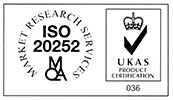
The retail landscape continues to shift, with budget or high-end retailers fairing slightly better than those in the middle.
At Critical we conducted our own research into the impact of the cost-of-living crisis, with 1,000 UK adults, who reported changing their attitudes to spending, with 78% claiming to be more cautious or strict with their budgeting.
It has had a huge impact on consumer spending, whether it be choosing to buy slightly fewer non-essential items, or being forced into dramatically altering lifestyles, most people’s relationship with spending has changed as a result, not just in choices and priorities, but in attitude and feelings. This means retailers and brands need to adjust the way they engage with their audiences or face being left out of touch.
You can read about our research into the cost-of-living crisis here.
The market continues to be a highly competitive industry with consumers having the choice of where to spend their money. Advancements in technology are resulting in more and more retailers entering the market, and competition grows and grows.
Brands and retailers should utilise market research to understand more about consumer behaviours, preferences, habits, and the relationships they have with their brand and their competitors.
With some of the best-known brands disappearing from the high streets, the focus on understanding customers, their needs, and behaviours has never been so relevant or timely.

Brands and retailers must speak to their consumers to better understand their target market and make better business decisions.
Market Research with Consumers
Speaking with consumers can aid brands and retailers with important business decisions, such as:
- Marketing Strategies and advertising approach
- Product portfolio
- Sales and promotion strategies
- Website design
- Social media campaigns
- Store layouts and planograms
- Staff training and development
- Corporate social responsibility (CSR)
By having robust consumer insight, these important business decisions can be made based on facts and figures and not off assumptions and guesses.

Consumer behavior changes and data can quickly become ‘old news’, so brands and retailers need to refresh and repeat their market research to evolve alongside their consumers.
Brands and retailers that fully embrace market research in their business strategies are able to avoid making assumptions. Whether it is a consumer survey or competitor analysis, brands and retailers have actionable data at their fingertips and can embed these into their decision-making.
Retail Market Research at Critical Research
We work with Retailers and Brands to help them adapt, evolve, and grow through knowledge and understanding of their consumer’s spending.
Our curious nature for all things people and how they connect with brands and retailers makes us extremely knowledgeable in this area. We design and manage each project from start to finish. Ensuring we are talking to the right people, developing a customised approach to establish not just good, but great conversations that allow us to delve into their decision-making processes.

Bespoke research projects are designed for our clients, encompassing qualitative and/or quantitative approaches. We tailor our approach based on our client’s needs, this can be a full market research service, from design to presentations, or access to our fieldwork team to collect high-quality consumer data.
As well as providing access to our highly respected fieldwork resource, we provide research design, implementation, reporting, and advanced statistical services.
We work with our clients on every step of their projects:
- Providing well-thought-out and informed research design
- Writing interesting and engaging questionnaires
- Collecting the data in ways that are engaging for the respondent, and produce good quality data
- Analysing the data using a range of statistical techniques
- Reporting the results using a story-based approach that makes the outcomes of the initial research question clear and interesting
There are occasions when we are asked to collect and deliver just the data using our fieldwork team.
We operate one of the UK’s most considerable CAPI field forces and offer a range of services from field & tab, through to mixed method projects combining different research approaches. Our team of fieldwork specialists is passionate about this sector, and extremely knowledgeable about consumers and how they shop.
- Face to Face (CAPI)
- Online (CAWI)
- Telephone (CATI)
- Focus Groups and Depth Interviews
Market Research Retail Portfolio
- Intercepts
- Customer Surveys
- Customer Segmentation
- Accompained Shops
- Competitor Analysis
- Social Listening & Monitoring
- User Experience
- Mystery Shopping
- In-store shopping events
1. Intercepts
Intercept surveys, whether on-site or online, enable in-the-moment engagement with people who have just had an interaction with the brand, store, or website. They are a very popular market research option, capturing in-the-moment opinions.
Interviewers approach shoppers in specific locations inside (aisles/categories), or as they are leaving a store and ask them about their customer experience.
Intercept surveys conducted in retail businesses can be used to collect data across a multitude of touchpoints, including:
- Brand awareness
- Packaging preferences
- Taste tests
- Point of sale and merchanding awareness
- Advertising recall
- Customer satisfaction
They are usually conducted on a tablet, which enables imagery and videos to be shown, as well as recordings, to record the data.
For eCommerce brands, website intercept surveys can be used. When customers visit the website, they are sometimes given the opportunity to provide feedback about their experience through a short questionnaire that appears in a window.
2. Customer Surveys
Gathering feedback from customers through surveys is a popular way to collect data that is fast, affordable, and can be measured.
For brands and retailers to really understand their customers, they need to speak to them and ask them their thoughts, and opinions, both positive and negative. By better understanding, the customer’s needs and wants, brands and retailers are able to turn negative experiences into positive changes, and this is what will make them stand out from the crowd.
The types of data that can be collected include:
- Net Promoter Score (NPS): On a scale of 1-10, how likely would you be to recommend this (brand/retailer) to someone else?
- Customer Satisfaction Score (CSAT): How satisfied were you with the service you received from (brand/retailer)?
- Customer Effort Score (CES): How easy was it to locate the (brands/products) you wanted to purchase from (retailer)?
Brands and retailers can also ask customers for NPS, CSAT, and CES of their competitors to see how they compare and distinguish where there is an opportunity to improve.
Investigating the impact of these factors can help to determine customer satisfaction and the value of a brand.
3. Customer Segmentation
By conducting market research to gain a deeper understanding of customer preferences and habits, businesses can utilise customer segmentation to keep customers engaged, discover new opportunities in niche markets, increase their return on investment, and adjust their pricing for optimal profitability.
As well as providing brands and the retail industry with feedback, customer surveys can also provide brands with segmentation data.
Customers can be grouped into market segments enabling brands and retailers to deliver targeted marketing messages that are more likely to have a greater impact than sending to the masses.
Customer segmentation can be based on the following:
- Demographics
- What other companies are doing
- Geographical area
- Customer behaviour and their purchasing behaviour.
Brands and retailers can use segmentation to inform marketing campaigns, pricing, product ranges, promotions, etc.
The benefits of customer segmentation:
- Retaining customers: customers tend to form a bond with businesses they identify with.
- Encouraging loyalty in customers is critical; developing strong relationships with them will make them more likely to remain loyal to the brand.
- Identify niche markets: successful brands need to understand niche markets within both smaller and larger groups of consumers.
- What are the commonalities that this audience shares?
- What type of items do they tend to be drawn to?
- How can I build a strong relationship with this group of people?
- Personalise marketing messages: by using segmentation, brands, and retailers know exactly who to target. The results are stronger relationships with their audience and higher ROI.
- Better pricing strategies: Customer segmentation collects key data to understand which pricing strategies work best, and good pricing helps with customer acquisition.
4. Accompanied Shops
Accompanied shops allow researchers to follow the consumer on their journey from the entrance to the exit of the store, to explore the many factors that impact their decision-making process. They can ask the consumer why they did/didn’t purchase a certain product, or why they stopped at a certain aisle or store display and therefore gather extremely in-depth feedback.
Researchers can observe how consumers…
- Adapt to alterations in store design
- Relate to product displays
- Recognise special offers or discounts
- Identify what encourages customers to buy.
5. Competitor Analysis
Retail is renowned for being one of the most competitive industries and therefore it is imperative to conduct market research on the competitors.
Competitive research can be conducted through a variety of means, including:
- mystery shopping
- primary qualitative or quantitative research
- secondary desk research
- social media monitoring
Once the data has been gathered, it can be compiled into a competitive analysis, giving the brand or retailer a complete overview of their competitors.
Competitive research may include:
- What a company offers to customers
- How they promote and advertise their business
- How they use social media to reach people
- How satisfied their customers are with the product or service
- How the product is designed
- What customers think of it through reviews or ratings.
It is vital for brands and retailers to stay competitive through their marketing, promotions, and customer satisfaction to be successful.
6. Social Listening and Monitoring
Brands and retailers need to stay in the know about the conversations that are happening online about their industry.
Staying attuned to and participating in digital dialogues regarding the industry, such as on social media platforms and in the media, allows businesses to make better-informed decisions.
Online reputation management (ORM) is a great market research tool for brands and retailers, and it can be used for:
- Keeping track of trends
- Managing reputation and potential crises
- Assessing the effects of marketing activities
- Monitoring competitors
Monitoring and listening to social media for the company’s name, any key terms, and direct and indirect competitors allows brands and retailers to forge positive relationships with current and potential customers.
7. User Experience (UX)
For stores that are based primarily online, conducting user experience research is essential for providing a positive customer experience, increasing customer loyalty, and ensuring satisfaction.
It is important for eCommerce websites to be aware of the factors that influence the user experience such as the speed of the website, the design, the search terms used to find it, the navigation, and the check-out process. UX research is a major part of retail market research and is essential for avoiding cart abandonment.
8. Mystery Shopping
Mystery shopping is great for seeing how a store is operating on a typical day.
A researcher assesses the store atmosphere, staff behaviour, and anything else that may affect a customer’s purchasing experience. Mystery shopping allows retailers to examine their operations in more detail and make changes to enhance their customer’s experience. By implementing the findings from mystery shopping, retailers can improve their staff training, customer service practices, and promotional materials, resulting in a significant return on investment.
9. In-store Shopping Events
This is a powerful opportunity to bring data to life by providing several advantages:
- Accessible Sample: Customers gathered together in one place without any recruitment costs.
- In the act: Truly spontaneous responses from customers whilst they engage with the brand.
- See the data in a new way: Observing the customer experience in real life gives a fresh perspective that can shed new light on key findings.
Quantitative approach: Face-to-face interviewing
Using our team of experienced face-to-face interviewers, we can collect survey data in person directly from the customers to:
- Complement ongoing brand tracking surveys
- Explore the in-store shopping experience
- Gather in-the-moment responses to new offers and products
Data protection principles
Data protection principles refer to the set of guidelines that must be followed to ensure the security and privacy of data. These principles are designed to protect the rights of the individuals whose data is being collected and stored.
The most important data protection principles are:
1. Transparency: Individuals must be informed about the data that is being collected, how it will be used, and who will have access to it.
2. Security: Appropriate measures must be taken to protect data from unauthorized access, accidental loss, and malicious attacks.
3. Accountability: Organisations must be accountable for the data they collect and store, and for how it is used.
4. Privacy: Individuals must have the right to control how their data is used, and to know who has access to it.
5. Integrity: Data must be accurate and up-to-date, and any changes must be tracked.
6. Access: Individuals must have the right to access and review the data that is collected about them.
These principles are essential to ensure that data is handled responsibly and securely. Organisations must adhere to these principles to protect the privacy and security of their users.
To speak to us about your research requirements please contact Sam Day.



